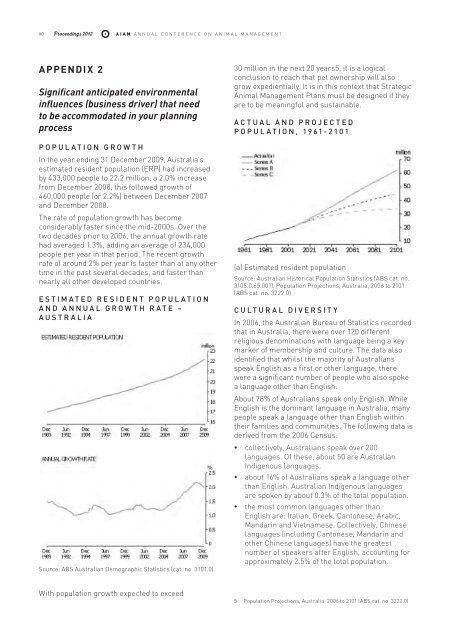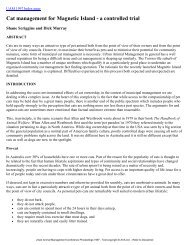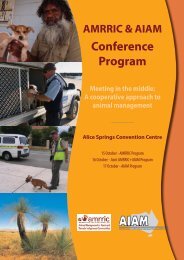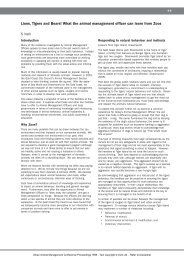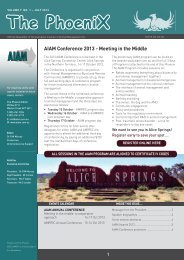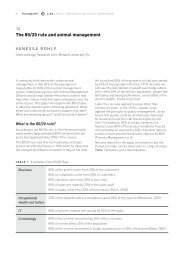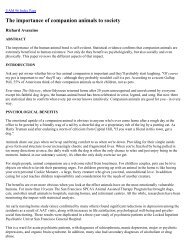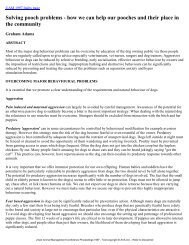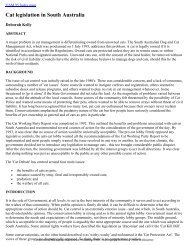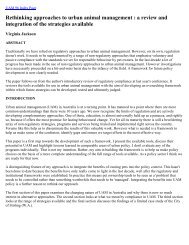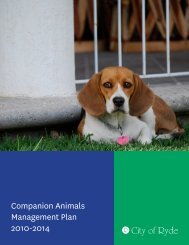Proceedings OF ThE - Australian Institute of Animal Management Inc
Proceedings OF ThE - Australian Institute of Animal Management Inc
Proceedings OF ThE - Australian Institute of Animal Management Inc
You also want an ePaper? Increase the reach of your titles
YUMPU automatically turns print PDFs into web optimized ePapers that Google loves.
80 <strong>Proceedings</strong> 2012<br />
AIAM Annual Conference on <strong>Animal</strong> <strong>Management</strong><br />
Appendix 2<br />
Significant anticipated environmental<br />
influences (business driver) that need<br />
to be accommodated in your planning<br />
process<br />
Population growth<br />
In the year ending 31 December 2009, Australia’s<br />
estimated resident population (ERP) had increased<br />
by 433,000 people to 22.2 million, a 2.0% increase<br />
from December 2008, this followed growth <strong>of</strong><br />
460,000 people (or 2.2%) between December 2007<br />
and December 2008.<br />
The rate <strong>of</strong> population growth has become<br />
considerably faster since the mid-2000s. Over the<br />
two decades prior to 2006, the annual growth rate<br />
had averaged 1.3%, adding an average <strong>of</strong> 234,000<br />
people per year in that period. The recent growth<br />
rate <strong>of</strong> around 2% per year is faster than at any other<br />
time in the past several decades, and faster than<br />
nearly all other developed countries.<br />
estIMATED resIdent POPULATION<br />
AND AnnuAL groWTH RATE –<br />
AustrALIA<br />
Source: ABS <strong>Australian</strong> Demographic Statistics (cat. no. 3101.0)<br />
30 million in the next 20 years5, it is a logical<br />
conclusion to reach that pet ownership will also<br />
grow expedientially. It is in this context that Strategic<br />
<strong>Animal</strong> <strong>Management</strong> Plans must be designed if they<br />
are to be meaningful and sustainable.<br />
ACTUAL AND ProjeCted<br />
POPULATION, 1961-2101<br />
(a) Estimated resident population<br />
Source: <strong>Australian</strong> Historical Population Statistics (ABS cat. no.<br />
3105.0.65.001), Population Projections, Australia, 2006 to 2101<br />
(ABS cat. no. 3222.0)<br />
Cultural Diversity<br />
In 2006, the <strong>Australian</strong> Bureau <strong>of</strong> Statistics recorded<br />
that in Australia, there were over 120 different<br />
religious denominations with language being a key<br />
marker <strong>of</strong> membership and culture. The data also<br />
identified that whilst the majority <strong>of</strong> <strong>Australian</strong>s<br />
speak English as a first or other language, there<br />
were a significant number <strong>of</strong> people who also spoke<br />
a language other than English.<br />
About 78% <strong>of</strong> <strong>Australian</strong>s speak only English. While<br />
English is the dominant language in Australia, many<br />
people speak a language other than English within<br />
their families and communities. The following data is<br />
derived from the 2006 Census:<br />
• ycollectively, <strong>Australian</strong>s speak over 200<br />
languages. Of these, about 50 are <strong>Australian</strong><br />
Indigenous languages.<br />
• yabout 16% <strong>of</strong> <strong>Australian</strong>s speak a language other<br />
than English. <strong>Australian</strong> Indigenous languages<br />
are spoken by about 0.3% <strong>of</strong> the total population.<br />
• ythe most common languages other than<br />
English are: Italian, Greek, Cantonese, Arabic,<br />
Mandarin and Vietnamese. Collectively, Chinese<br />
languages (including Cantonese, Mandarin and<br />
other Chinese languages) have the greatest<br />
number <strong>of</strong> speakers after English, accounting for<br />
approximately 2.5% <strong>of</strong> the total population.<br />
With population growth expected to exceed<br />
5 Population Projections, Australia, 2006 to 2101 (ABS cat. no. 3222.0)


